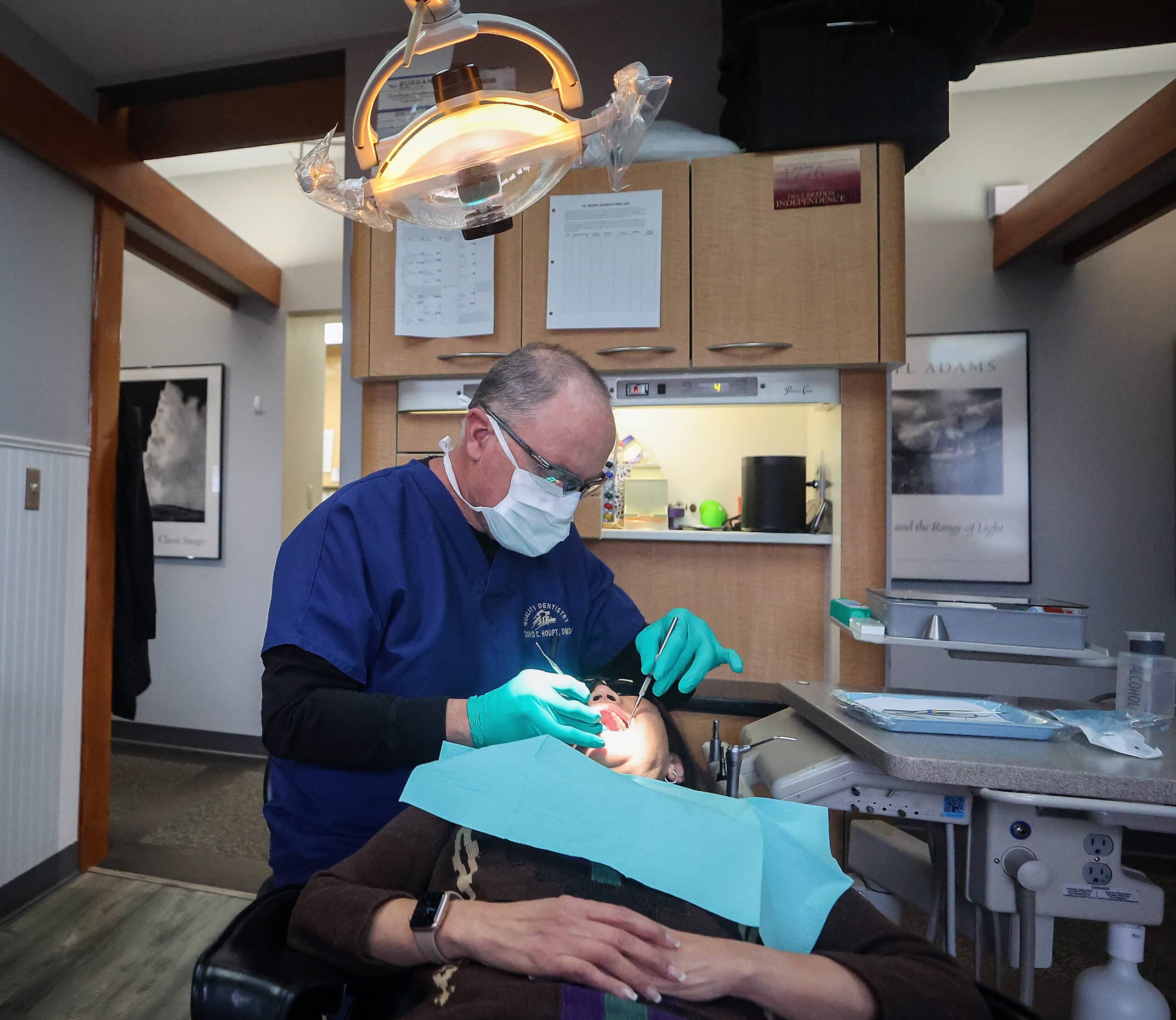Community Health & Wellness
As debate over fluoride returns, Gig Harbor remains a rare city without it
In April 1997, the Bremerton City Council approved adding fluoride to the city’s water system after a group of residents identified children’s dental health as a major issue there.
Health & Wellness Sponsor
Health and Wellness stories are made possible in part by Virginia Mason Franciscan Health, a proud sponsor of Gig Harbor Now.
Port Orchard, Poulsbo and Bainbridge Island and many other American water providers started fluoridating their water over the previous half-century. Extensive evidence showed it reduced cavities and tooth decay. At an annual cost of less than $2 per customer, the decision was regarded as a common-sense and cost-effective measure.
But before it could begin, an anti-fluoride citizen group petitioned the city council to put the decision before voters. During a special election nearly two years later, residents rejected the proposal and outlawed any future action on fluoridation without a public vote.
That left Bremerton as one of two cities on the Kitsap Peninsula that does not fluoridate its water. Gig Harbor is the other.
Who benefits the most
Experts say children and low-income residents are harmed the most by the lack of fluoridation.
Today, most benefits from fluoride can be achieved through proper dental hygiene and regular check-ups, said Dr. David Houpt, a dentist in Silverdale and a member of the Kitsap Dental Society. Its “greatest impact” is on “folks who cannot regularly get to the dentist or afford quality dental equipment like an Oral B or Sonicare” toothbrush.

Dr. David Houpt looks over a patient’s teeth during a checkup at Old Town Dental in Silverdale on Friday, Jan. 3, 2025.
Almost all water contains some organic amount of fluoride, a naturally occurring mineral, although typically not enough to prevent cavities. American cities began community fluoridation in 1945 after scientists discovered that people living in areas with naturally high concentrations of fluoride had lower rates of decay.
The practice has become a cornerstone in the United States. Over 70% of public water systems contain fluoride. The Centers for Disease Control hailed the introduction of fluoride as one of the top public health achievements of the past century.
“Community water fluoridation adjusts the concentration of fluoride to a level that is safe and optimal for preventing tooth decay and is a proven public health prevention measure that benefits both children and adults, regardless of age, race, gender, or income,” Dr. Gig Morrow, Kitsap’s top public health official wrote in an email. “When in contact with teeth, it helps to repair early signs of tooth decay, hardens the tooth’s surface, and slows decay-causing bacteria.”
Debates continue
Despite broad backing among public health officials and dentists, debates like the one in Bremerton over 25 years ago persist. In recent months, dozens of American communities are reconsidering fluoride’s merits and removing it from their water, according to the Associated Press.
In a phone interview, Dr. Charlotte Lewis, a professor of pediatrics at the University of Washington who studies oral health and dental care disparities, said anti-fluoride efforts have been around for decades and come up occasionally.
“For a long time, people have been trying to connect fluoride in the water with something bad,” she said. “Even dating back to the ’60s, with Communist plots and conspiracy theories and things like that.”
New fluoride skeptics
Quarrels over fluoride resurfaced in the national media recently in part due to comments made by Robert F. Kennedy Jr. Kennedy, also a vaccine skeptic, is President-elect Trump’s choice to lead the Department of Health and Human Services.
Kennedy declared in November he would call for removal of fluoride from the country’s drinking water.
A controversial federal report published in August by the National Toxicology Program also appears to have added to public skepticism. The report found with “moderate confidence” that fluoride levels at rates twice the recommended limit were associated with lower IQs in children. It did not address the effects of fluoride at the recommended concentrations outlined by the CDC.
Based heavily on the report and other studies, a federal judge in California ordered in September that the Environmental Protection Agency further regulate fluoride in water over concerns about its impacts on cognitive decline.
Some research has found a connection between low levels of fluoride and adverse outcomes, like lower IQ or cognitive ability, Lewis said. However, many of them have “a lot of problems” and there are a number of “better designed” studies that have found no relationship.
“The concern of the American Academy of Pediatrics and people like myself who have spent a lot of time studying these things is that we’re drawing these conclusions based on faulty studies,” she said. “We still have a lot of disparities in oral health in this country and a lot of difficulty accessing dental care for many groups. There’s research that shows if you drink fluoridated water, a lot of those disparities disappear.”
Local choices
Morrow said local and state officers are aware of the national toxicology report and that Washington state Department of Health officials are examining its findings. The Kitsap Public Health District continues to support fluoridation as a “sound” health measure.
“We know that fluoridation reduces tooth decay in children and adults, helps address disparities for families with low incomes, and saves money by reducing the need for dental treatment,” he said. “People who live in communities with fluoridated water are more likely to have healthier teeth than those living in communities without fluoridated water.”
The federal government does not have the authority to order municipalities to remove fluoride. Those decisions fall on local water districts and city councils. That has caused some variances in neighboring communities, like on the Kitsap Peninsula.
Most unincorporated sections of the Peninsula, across Pierce and Kitsap Counties, do not have fluoridated water. Annapolis and Manchster, which approved fluoridation in 1968, are the exception. The Port Gamble S’Klallam Tribe also fluoridates its water in North Kitsap.
Little talk of fluoridation in Gig Harbor
The Tacoma-Pierce Health Board passed a countywide fluoridation mandate in the early 2000s, requiring all public water systems to be fluoridated. But the state Supreme Court struck it down in 2004, according to archives of the Tacoma News Tribune. Justices did not debate the merits of fluoride, but rather ruled the mandate was an overreach of the board’s authority. The state Board of Health rejected a statewide mandate in the 1970s.
Aside from Bremerton, Gig Harbor is the only other incorporated city that does not fluoridate its water, according to a list maintained by the Washington DOH.
Excluding a 1974 vote by the Gig Harbor Town Council, which unanimously opposed any state efforts to require fluoridation in local water, there appear to be few instances of debates over fluoride in Gig Harbor.
State Rep. Michelle Caldier, R-Gig Harbor, was a teenager living in Bremerton during the 1990s when residents debated fluoride. Caldier said she was unaware of a similar debate in Gig Harbor. No constituents have reached out to her about fluoridation issues.
Caldier, a former dental professional, said she supports fluoridation — but where the local community endorses it.
“For some communities if they don’t have high cavity rates, it doesn’t make sense to fluoridate the water,” she said. “I’m a supporter of fluoridated water within regions that have high cavity rates as long as the community supports it.”
Absences of fluoride
Disparities in oral health between communities that choose to fluoridate and those who do not is less dramatic today than it was decades ago, said Lewis, the UW professor. Most communities had virtually no exposure to adequate levels of fluoride, prior to its introduction in community water systems. That made its presence in the following decades particularly impactful.
Communities with fluoridation still have lower cavity rates and health outcomes, but the rise of toothpastes with fluoride and the increased number of food made in communities with fluoridated water have helped expand access to the mineral outside of drinking water.
Yet that does not mean community fluoridation is no longer necessary, Lewis said, comparing it to the polio vaccine. The polio vaccine largely eradicated the disease — so some people question why it is still necessary, she said. That hesitancy can contribute to preventable cases.
“It’s similar to community water fluoridation. We don’t see that many cavities or anywhere near as many cavities as we did or in the 20th century,” she said. “That’s because of community water fluoridation. If we take that away, the expectation is that we will start to see a lot more cavities.”

